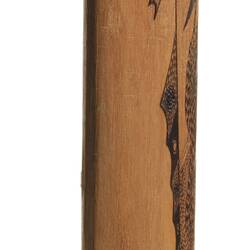Summary
Uncle Albert Mullett (1933-2014) was a senior Elder of Gunai/Kurnai Peoples of Gippsland. Uncle Albert was committed to the preservation, illumination and celebration of Aboriginal culture. He fought for the rights of his people and was instrumental in forcing legislative changes which allowed local Aboriginal communities to have active involvement in the management of culturally significant sites throughout Victoria. Uncle Albert was also instrumental in establishing a Keeping Place in Bairnsdale which has allowed his people to have a more active role in the maintenance and rightful possession of their cultural knowledge and heritage.
For more than 15 years, Albert led his people's fight for native title recognition. On 22 October 2010, the Federal Court of Australia recognised the claim of the Gunai/Kurnai people over much of Gippsland. On the same day, the Victorian Government entered into an agreement with the Gunai/Kurnai people under the Victorian Traditional Owner Settlement Act 2010. It was a momentous occasion for Albert, who went on to play a prominent role on the Gunai/Kurnai Elders' Council.
This shield is a monument to Uncle Albert's standing as a master craftsman. Made with his son Collon, it is also testament to the dedication he continuously showed to passing skills and knowledge on to the younger generations. Uncle Albert was highly respected for his skill in making traditional wooden artefacts, such as shields and boomerangs. He was a storyteller who educated and advised people of all ages about Aboriginal culture, including his 17 grandchildren and 15 great-grandchildren.
Uncle Albert passed away in July 2014. Although he is sadly missed, he will always be remembered as a leader who possessed wisdom, integrity and fortitude, and was a powerful role model to many people, both Indigenous and non-Indigenous.
Local Name
Karragame
Physical Description
Shield made of yellow stringy bark wood. Oval shaped with no handle. Hot pokerwork designs depict a fish infilled with predominantly linear designs. The skeleton and intestines are highlighted. Circular designs at each end. Plano-convex cross section. Posterior is flat and plain.
Significance
For countless generations, the lakes, tributaries and sea coast of Gippsland in southeastern Victoria has provided the Gunai/Kurnai people with ample fishing and hunting grounds, supplying an abundance of fresh fish such as Bluethroat Wrasse and Bream along with shellfish such as lobsters, crabs and oysters.
This karragame (shield) depicts a kine (fish) specifically a Bluethroat Wrasse, which had been burnt into the yellow string bark wood surface. It was crafted by Albert Mullett and decorated by his son Collon using an artistic style known as X-ray art. This design depicts the skeleton and internal organs of the animal, and is generally characteristic of northern Australian designs and less commonly seen in southeast Australian Aboriginal art.
Uncle Albert speaks of the intergenerational transmission of skills and knowledge he was so devoted to throughout his life;
'I'm very proud of the knowledge that has been passed on. When I was a little boy a lot of full-blood people were still alive and I was very fortunate to see some of the last corroborees performed in this area by my uncles and great-uncles. I can remember one old bloke, Uncle Garney, he'd say "Come and sit here. But you listen, don't talk." So we'd sit there for maybe an hour and he'd just do all this talking and doing diagrams in the dirt with a stick or with his waddy and tell us what they mean. And I was so very privileged to be able to experience that. He was a very clever old fella.'
Uncle Albert Mullett, 2010.
References
Keeler, C. and Couzens, V., (eds) 2010, Meerreenng-An: This is my Country: The Story of Aboriginal Victoria Told Through Art, p. Koorie Heritage Trust/ BPA Print Group, pp. 41, 233.
More Information
-
Object/Medium
Shield
-
Locality
-
Date Produced
-
Object Measurements
710 mm (Length), 215 mm (Width), 35 mm (Height)
-
Classification
-
Date Made
-
Maker
-
Clan/Language Group
-
Place Made
-
Indigenous Region
-
Keywords
-
Type of item
-
Discipline
-
Category
-
Collecting Areas



